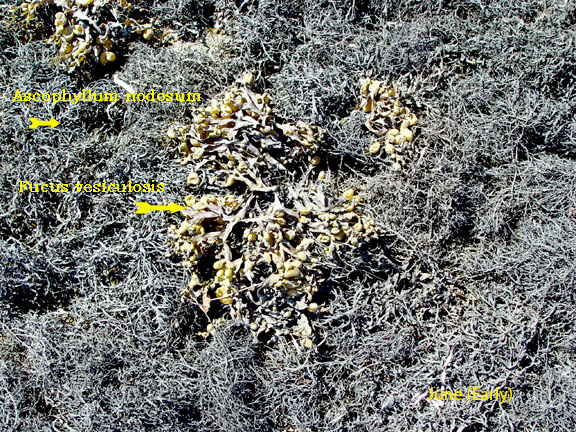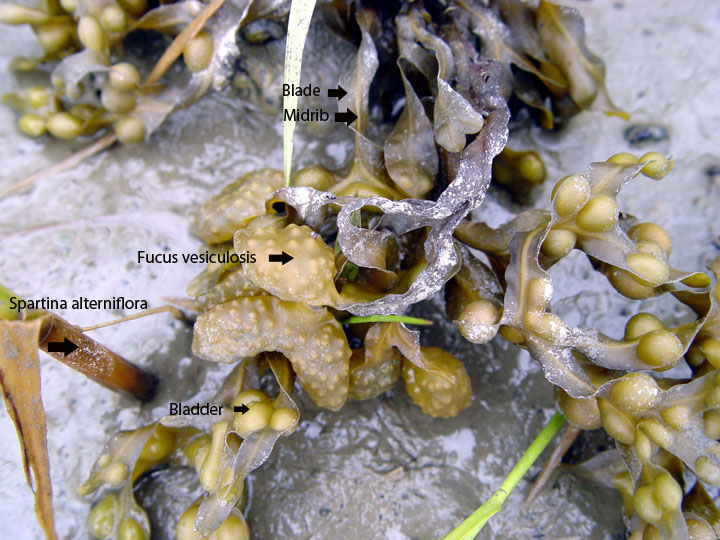Zone 2: Spartina alterniflora
A. General Information:
Salt-water Cord Grass is the dominant organism here. It is able to out-compete other species because of its ability to tolerate daily exposure to seawater, move essential oxygen to the roots through a series of channels that extend from leaf to root, and its ability to quickly occupy available space by extending underground stems to new locations. Each of these adaptations are discussed in more detail below.
B. Description of Spartina alterniflora:
Spartina alterniflora (Salt-water Cord Grass)(Poaceae, Grass Family)
http://en.wikipedia.org/wiki/Spartina_alterniflora
http://plants.usda.gov/java/profile?symbol=SPAL









Just above the mud flats, one often finds tall Spartina alterniflora plants. The tall form is visible in the fifth photograph. These plants are generally taller and greener than members of the same species (Short Form) found slightly higher on the marsh. Both long and short cord grass are genetically identical suggesting that the difference in height is most likely due to the greater availability of nitrogen in the lower marsh. Cordgrass has an extensive network of underground rhizomes (Underground Stems) that anchor the plant in place. Roots extend downward and stem and leaves grow upward from the rhizome. This form of asexual reproduction allows the plant to quickly colonize new areas. Cordgrass also reproduces sexually (Note the flowering plants below) resulting in the production of large numbers of seeds that are carried by tidal water throughout the marsh. This however is a slow process compared to asexual reproduction. In the fall the above-ground leaves die. The underground biomass (Rhizomes and Roots for the most part) remain alive, protected from environmental extremes such as low temperatures and the grinding movement of ice cakes.
Spartina has a number of interesting adaptations that allow it to live in salt water. Plants are partially covered by seawater during most high tides (Refer to the last photograph). Fresh Water is able to move into the plant osmotically because the root cells concentrate salts (mainly sodium) above that in seawater creating an inward flow. Excess salts that tend to accumulate internally are removed from the plant by epidermal salt glands. White flecks of salt can be seen on the leaf surface. The below ground biomass grows below the mud surface where there is little oxygen necessary for the plant to produce energy for its metabolic needs. This dilemma is solved by the transport of air through a continuous system of internal tubes (Spaces)(Aerenchyma) that lead from leaves to roots. When temperatures rise, the plant is able to cool itself by coating the leaf with water drawn by transpiration from the roots. This is a form of evaporative cooling.
At the end of the growing season the above ground biomass is decomposed first by fungi and then by invading bacteria. The aerenchyma provide a pathway for fungi to enter the plant speeding up the decomposition process. The plant material is broken into smaller pieces as decomposition proceeds and the pieces are colonized by bacteria which are then consumed by a variety of organisms.
A variety of chewing insects feed on the living plant. Grasshoppers for example often consume Spartina leaves. Several species of aphids can penetrate the plant with their proboscis, sucking out plant juices. Snails such as Melampus and Littorina feed by scraping plant epidermal cells, films of diatoms and other attached algae, from Spartina leaves and stems.
Adaptations:
1. Salt glands that remove excess salt from water taken into the plant osmotically.
2. Hollow tubes that conduct air from the leaves into the roots.
3. Relatively long rhizomes that allow the plant to quickly colonize new areas.
4. Ability to grow in areas inundated by salt water daily.
C. Animals and Plants Often Associated with Spartina
alterniflora
1. Molluscs
Phylum Mollusca, Class Gastropoda
Littorina saxatilus (Rough Periwinkle)
http://en.wikipedia.org/wiki/Littorina


The rough periwinkle feeds on films of detritus containing a mixture of bacteria, micro algae, and small pieces of marsh grasses, with its radula.
Adaptations:
1. Elongated radula with scraping teeth that allow the snail to remove films of micro-organisms and detritus from the marsh surface and from Spartina leaves.
2. The ability to “glue” the shell to a solid surface such as a Spartina leaf by secreting mucus around the inner shell opening.
3. Lightly colored shells that tend to reflect light rather than absorb it.
Phylum Mollusca, Class Bivalvia
Modiolus demissis (Ribbed Mussel)
http://en.wikipedia.org/wiki/Modiolus


The ribbed mussel filter feeds in the same way as the soft shelled clam discussed in Zone 1 (Mudflats).
Adaptations:
1. Has a hard shell that protects them from predators.
2. Secretes tough protein threads that extend from the foot (Byssal Threads) and attach to hard surfaces, holding them firmly in place.
2. Plants (Algae and Higher Plants) Associated with
Spartina alterniflora
A. Brown Algae (Phaeophyta)
a. Ascophyllum nodosum (Knotted Wrack)
http://en.wikipedia.org/wiki/Ascophyllum_nodosum




Ascophyllum, a common rocky intertidal inhabitant, is characterized by twisted flattened, dichotomously branched, thalli (fronds) (Thinner and more twisted in marsh specimens), and has bladders (Fewer in marsh specimens) along its length. Short lateral branches arise along the thallus on all but the most distal parts. Each lateral shoot may form a receptacle (Rare in marsh plants). Fucus and Ascophyllum have similar life cycles. Refer to the description of Fucus below. Ascophyllum may be attached by a holdfast to a solid object or lie unattached, trapped in place around the bases of Spartina plants. It is harvested for use as a fertilizer and for its health benefits.
Adaptations:
1. A many branched, twisted thallus that significantly increases the surface area that is exposed to light.
b. Fucus vesiculosis (Rock Weed)
http://en.wikipedia.org/wiki/Fucus



Fucus has a plate-like holdfast that attaches to the substratum and a branching thallus. The thallus is relatively flat and dichotomously branched. A mid-rib is located in the middle of the thallus. Fucus vesiculosis has paired gas bladders on its thallus that buoy the plant up in the water column providing maximum exposure to sunlight used in the process of photosynthesis. Each terminal branch of the thallus ends in a swollen receptacle in mature plants as shown above. Reproductive organs are found in round pits (conceptacles) on the inside walls of receptacles. Motile sperm from male conceptacles fertilize eggs released from female conceptacles and the embryo attaches to the bottom and grows into the Fucus plant . In the marsh the fronds are twisted spirally and there are a greater number of bladders compared to the same species on rocky shores. There are also fewer receptacles on marsh plants. Dried and ground fronds are used to flavor food and as a health food additive.
Adaptations:
1. A many branched, twisted thallus that significantly increases the surface area exposed to light.
2. A disc-shaped holdfast that anchors the alga to a solid surface.
B. Higher Plants
Chenopodiaceae (Goosefoot Family)
a. Salicornia maritima (Glasswort)
http://en.wikipedia.org/wiki/Salicornia
http://plants.usda.gov/java/profile?symbol=SAMA11


This succulent species colonizes bare areas and vegetated locations within both Spartina Zones. Glasswort, about 13 cm high, has an erect, jointed, main stem with jointed lateral branches. The leaves, formed at each joint, are reduced to scales. The stem arises from a taproot. The plant turns bright red. as shown above, in the fall. Sodium is concentrated in cell vacuoles, allowing Salicornia to draw relatively freshwater osmotically into the plant. Consequently, this species has a salty taste and is often used as a flavoring agent in soups and salads.
Adaptations:
1. Responds to high salt concentrations by forming cells with greater volume such that salt taken into these cells is effectively diluted to non toxic levels. This is typical in succulent plants.
b. Suaeda linearis (Erect Sea Blite)
http://en.wikipedia.org/wiki/Suaeda
http://plants.usda.gov/java/profile?symbol=SULI

















I am blown away by the beauty and range of these flora and fauna of a salt marsh, and by the expertise and detailed explanations of the author of this study!
Thanks, Doc!
This is so beautiful! Alas, I could not find what my grandfather called “Bay Heather’ here…..but beautiful and informative nonetheless
Hello, after reading this awesome post i am also cheerful to share my know-how here with colleagues.
Hello, Robert,
My name is Lauren; I am a graduate student in landscape architecture with the University of Georgia. I am writing to obtain permission to reference and use the image you created of the Spartina roots with labels in my master’s thesis, which will be publicly available online via the university’s repository. Thank you for your time.